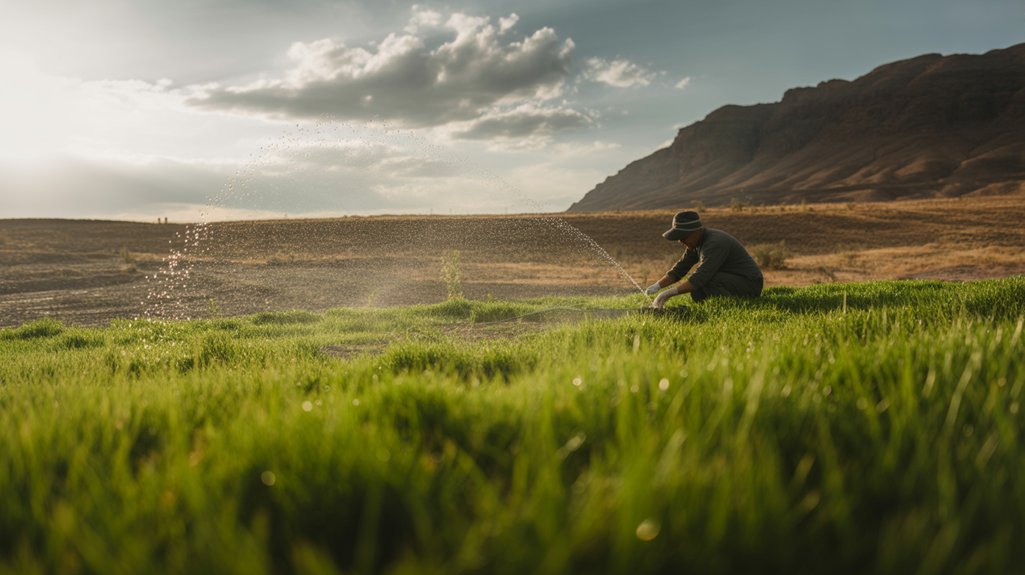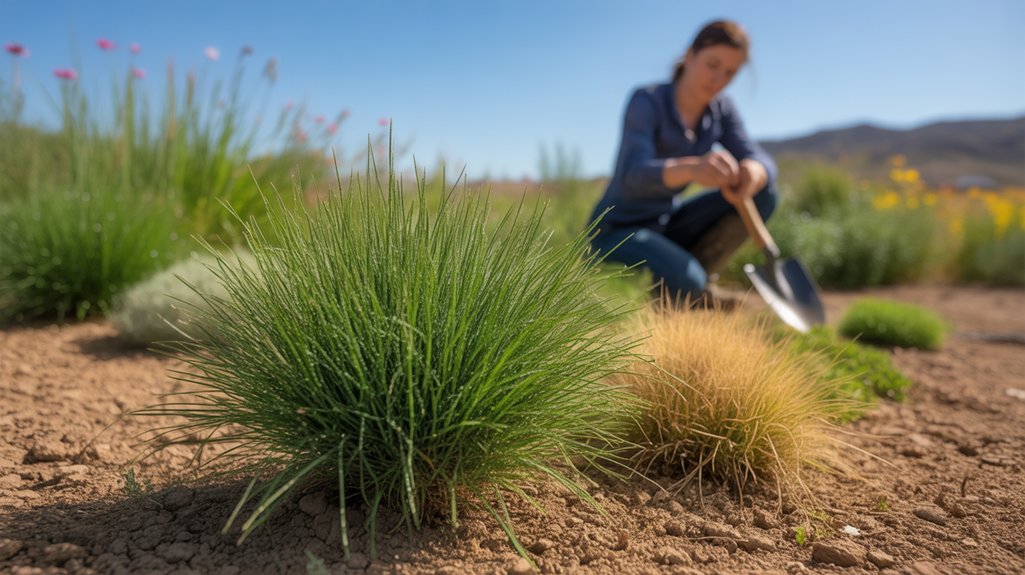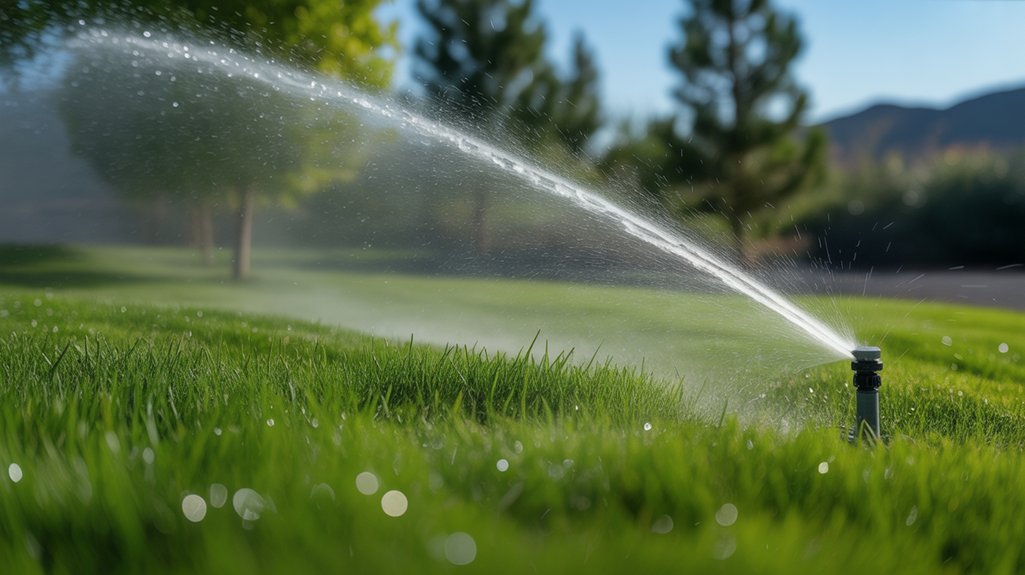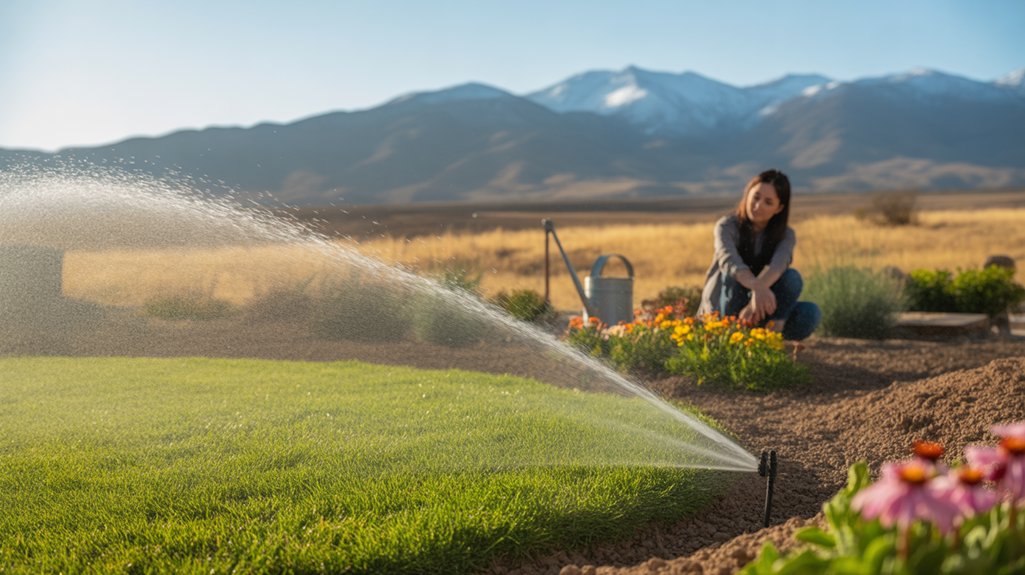Keeping your lawn healthy in Arvada during Colorado’s dry months can be challenging, but it’s achievable. Selecting the right grass types and using effective watering techniques are key to thriving in the arid climate. Moreover, understanding soil health and regular maintenance makes a significant difference. Let’s explore essential steps for lawn hydration in Colorado to ensure your Arvada yard stays green and resilient.
Understanding Colorado’s Climate Challenges

To achieve lawn hydration in Colorado, first recognize Arvada’s unique climate challenges. The high altitude and seasonal variations stress grass, with hot summers drying soil quickly and cold winters causing frost damage.
For instance, adapting to these conditions with tailored watering schedules and fertilization ensures resilience. Moreover, timing lawn care with seasonal changes is crucial. By addressing Arvada’s climate, you’ll maintain a lawn that thrives year-round.
Selecting the Right Grass Types for Drought Resistance

Choosing the right grass types is key to creating a drought-resistant lawn in Colorado’s challenging climate. Start by considering native grass options, as they’re adapted to local conditions and require less water.
Varieties like Blue Grama and Buffalograss are excellent choices, thriving in dry environments while maintaining a lush appearance. Additionally, look for drought-tolerant varieties like Fescue, which have deep root systems that help them survive during dry spells.
These grasses not only conserve water but also require less maintenance compared to traditional lawns. By selecting the right mix of native and drought-tolerant grasses, you’ll create a resilient lawn that stands up to Colorado’s dry months, ensuring your yard stays healthy and vibrant throughout the season.
Effective Watering Techniques for Optimal Growth

To maintain lawn hydration in Colorado, master watering techniques. Drip irrigation delivers water directly to roots, reducing waste and promoting healthy growth. For example, water early in the morning or late evening to minimize evaporation in Arvada’s heat. Moreover, deep watering sessions encourage stronger roots.
Remember to adjust your watering schedule based on rainfall and temperature changes. By implementing these techniques, you’ll promote optimal growth while practicing water conservation, ensuring a lush and resilient lawn throughout the season.
The Importance of Aeration and Soil Health
While often overlooked, aeration is critical for soil health and lawn hydration in Colorado.
Soil compaction restricts air, water, and nutrients from reaching roots. By aerating, you create holes for better water penetration, enhancing hydration and root growth.
For instance, regular aeration in Arvada during dry months boosts drought resilience. Additionally, it improves nutrient absorption, ensuring a healthy, vibrant lawn that thrives in Colorado’s arid climate.
Mulching: A Simple Solution for Moisture Retention
Mulching is a simple way to support lawn hydration in Colorado. A layer of mulch reduces evaporation, keeping Arvada soil moist.
Moreover, it suppresses weeds and regulates soil temperature. Choose organic mulch, like wood chips or grass clippings, to enrich soil, or inorganic options, like gravel, for durability. Apply a 2- to 4-inch layer around plants.
By mulching, you’ll maintain a hydrated, healthy Arvada lawn during dry months.
Lawn Mowing Best Practices for Summer Health
As summer heat bears down, mowing your lawn properly becomes crucial for maintaining its health.
Start by adjusting your mowing height; keeping your grass around three to four inches tall helps retain moisture and encourages deeper root growth. Longer grass also provides shade for the soil, reducing evaporation.
Mowing frequency is another key factor. During the hottest months, aim to mow every 7 to 10 days, depending on growth rates.
Avoid cutting more than one-third of the grass blade at a time, as this can stress your lawn. Remember to keep your mower blades sharp for a clean cut, which reduces the risk of disease.
Following these practices will ensure your lawn stays vibrant and resilient through the summer.
Fertilization Tips for a Resilient Lawn
To keep your lawn resilient, applying the right fertilizer at the right time is essential. Consider using organic fertilizers, as they provide a natural option that promotes healthy grass without harmful chemicals.
Look for products that contain slow release nutrients, which gradually nourish your lawn over time, reducing the risk of nutrient runoff. Timing is crucial; fertilize in early spring and again in late summer to support growth during the dry months.
Remember to water your lawn after fertilizing to help the nutrients penetrate the soil. Always follow the recommended application rates to avoid over-fertilization, which can stress your grass.
Recognizing and Managing Lawn Pests and Diseases
While maintaining a healthy lawn, recognizing and managing pests and diseases is crucial for preventing damage.
Start with pest identification; regularly inspect your grass for signs of insects like grubs or chinch bugs. Look for discoloration, wilting, or dead patches that indicate a problem. Once identified, you can choose targeted treatments, such as insecticidal soap or beneficial nematodes.
For disease prevention, ensure proper watering and mowing practices to promote resilience. Aerating the soil and maintaining good drainage can help reduce fungal diseases.
Additionally, applying a balanced fertilizer strengthens your lawn’s natural defenses. By staying vigilant and proactive, you can keep your lawn thriving through Colorado’s dry months, minimizing the impact of pests and diseases.
Frequently Asked Questions
How Often Should I Water My Lawn During Drought Conditions?
During drought conditions, you should water your lawn deeply but infrequently, around once a week. Use efficient watering techniques and focus on drought tolerance to help your grass thrive despite limited moisture.
Can Lawn Care Products Harm My Pets or Children?
Yes, some lawn care products can harm your pets or children. Always choose pet safe fertilizers and child friendly pesticides to ensure their safety while maintaining your lawn. Read labels and follow instructions carefully for the best results.
What Are the Signs of a Lawn Needing More Water?
If your lawn’s showing signs of dry grass and wilting leaves, it’s time to water. Look for faded color, crunchy texture, and footprints that remain visible. Don’t wait too long; your grass needs help!
Is It Safe to Use Gray Water for Irrigation?
Using gray water for irrigation can be safe, as long as you follow proper gray water safety guidelines. Implementing appropriate irrigation techniques ensures your plants thrive while minimizing potential risks from contaminants in the water.
How Can I Prevent Weeds in a Dry Lawn?
To prevent weeds in your dry lawn, maintain healthy grass by mowing regularly and applying mulch. Water deeply but less frequently, and consider using a pre-emergent herbicide for effective weed prevention during dry spells.
By choosing drought-resistant grass types and implementing smart watering techniques, you can keep your lawn thriving even during Colorado’s dry months. Regular aeration and mulching will boost soil health and moisture retention, while proper mowing and fertilization keep your lawn vibrant. Don’t forget to monitor for pests and diseases to ensure your lawn stays resilient. With these tips, you’ll enjoy a lush, healthy lawn all summer long.
By choosing drought-resistant grasses and using smart watering techniques, you can maintain a healthy lawn in Arvada’s dry climate. For expert guidance implementing these strategies, contact Above & Beyond Services to ensure your yard stays resilient. Remember that consistent aeration and proper mowing are also crucial for boosting soil health and helping your lawn thrive through the driest months.
Key Takeaways
-
Blue Grama and Buffalograss thrive in Arvada’s dry conditions, ensuring lawn hydration in Colorado.
-
Drip irrigation delivers water efficiently, minimizing evaporation for optimal hydration.
-
Water early morning or late evening to enhance lawn hydration in Colorado and reduce water loss.
-
Aerate regularly to improve soil health and water absorption in Arvada yards.
-
Monitor pests and diseases, using proper treatments to maintain a healthy lawn.




